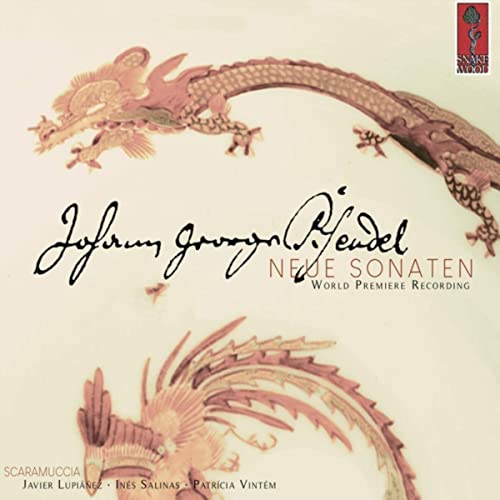Scaramuccia
59:14
Snakewood SCD202001
Click HERE to buy this as a digital download from amazon.co.uk
Through the meticulous and studious investigation, plus careful comparative studies of some formerly unattributed violin sonatas from Dresden’s Schrank II, now found at the Sächsische Landesbibliothek – Staats -und Universitätsbibliothek Dresden, the astute director and violinist, Javier Lupiañez of Scaramuccia, has drawn on previously known works to build a convincing case for Pisendel’s authorship of these delightful “new sonatas”. The displays of ornamentation are drawn from those indicated by Pisendel, and Javier’s own inspired applications which seem perfectly placed within this frame. One can hear why Telemann was so enamoured by Pisendel’s obvious and fluent skills; indeed, I’d venture that emulation in some works by the former from the musical impetus of the latter’s abilities seem very clear. Excellent, too, to also have Telemann’s poetic memento mori (Published by J. A. Hiller, Leipzig 1766) reproduced in its original German (p. 14) with English translation (p. 18) from which we can glean a real personal sense of wonder and keen admiration: (3rd stanza) “Raised in Music’s bosom, surpassing great masters, and by quill, finger and bow, becoming their leader.” The fine 1682 violin (on loan) sails through these sprightly and wonderfully shaped sonatas with a blend of warm, melodious invention and applied virtuosity. A lovely, well-crafted yet anonymous D-major harpsichord sonata provides both a break and bridge before regaining the trail of these so-termed “Neue Sonaten” with the A-minor and concluding G-major works. The CD notes give some lucid insights into the approach to performance (p. 23). The final Allegro en Rondeau (Track 20) had in the draft manuscript ten different themes by Pisendel! The cadenza just before the last theme in the first movement of the A-minor piece is original Pisendel.
This is a fine new “clutch” of pieces by the Dresden-based master, displaying his own prowess and engaging style which encompasses that high-flown Italianate and a warm lyricism, the latter most often found in the heartfelt, slower movements. When baroque music is so convincingly and attractively presented it is hard to resist the charms and delights which begin with the booklet cover details of the delicate Chinese porcelain designs for a service made in the 1730s for the Dresden ruler. Images of dragon and phoenix together were traditionally used at marriages; here the marriage of Scaramuccia and Pisendel, a felicitous meeting worthy of attention and sincere accolades.
David Bellinger
